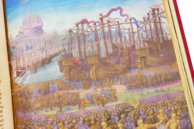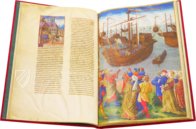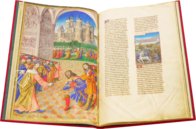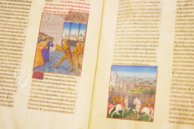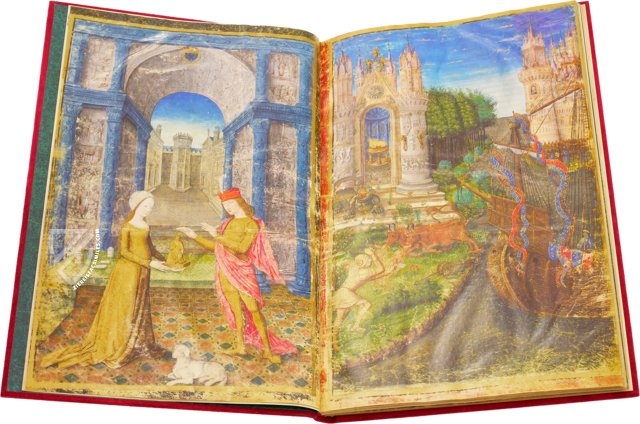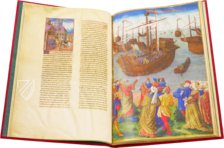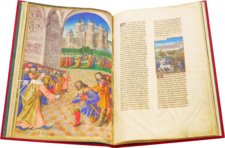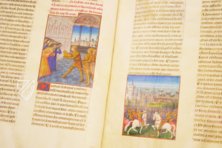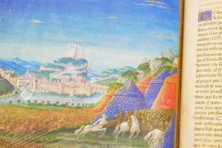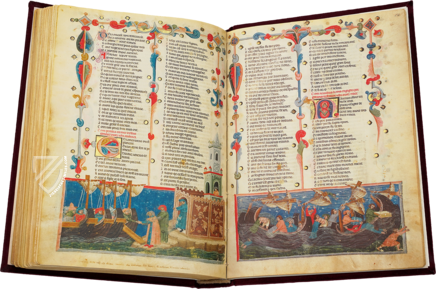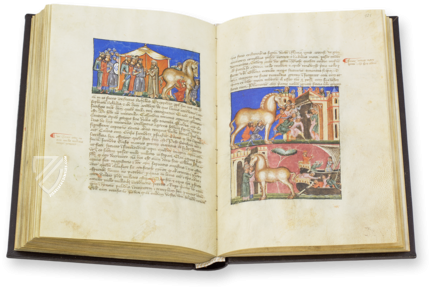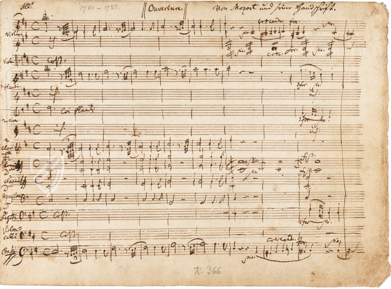History of the Trojan War
This elaborate manuscript of the legendary History of the Trojan War, now preserved in the Bibliothèque nationale de France, is one of the most beautiful handwritten documents of the millennia-old tradition of this epic material. It was illuminated around 1500 by the workshop of the famous master Jean Colombe (c. 1430 – c. 1493) and signed by his son François. Commissioned by the French governor Aymar de Poitiers (died 1510), the talented illuminators created a breathtaking panorama of the ancient myth, consisting of 83 expressive, moving images that not only accurately depict the captivating events of the story, but are also a fascinating source about contemporary everyday life in France. The basis for this impressive illumination is a French translation of Guido de Columnis' (1210–1287) literary adaptation of the Trojan epic, which the Italian author completed in the year of his death, 1287, and which was to belong to the European canon of this much-adapted material for centuries to come.
History of the Trojan War
The mythological tale of the Trojan War is without a doubt one of the most influential and oft-adapted legends of all time. It has been continuously adapted in various forms, the most recent of which was the Oliver Stone blockbuster Troy with Brad Pitt and Orlando Bloom in the leading roles. The timeless saga has also been reworked countless times in literature. The Italian author Guido delle Colonne dedicated himself to the ancient material in the year 1287. He produced one of the most important literary editions of the epic, which was cited and reworked throughout the entire Middle Ages. Ca. 1500, the Italian’s masterpiece was furnished with epic illustrations in the art studio of the French illuminator Jean Colombe. The result was one of the most astounding illuminated manuscripts in the history of medieval book art. The manuscript is an unbelievably richly furnished picture book with artistic and historically informative miniatures on practically every page.
The History of the Trojan War by Guido delle Colonne
Guido delle Colonne was an Italian author who lived in 13th century Messina. His most famous work was his successful History of the Trojan War. Delle Colonne did not use Homer’s famous epic the Iliad, which was only known in Western Europe from hearsay at that time, as a template for material, but rather made use of two depictions of the Trojan war supposedly composed by eyewitnesses. In doing so, it is the descriptions of Dictys Cretensis, who supposedly experienced things from the Greek side, as well as the account of Dare Phrygius, who was supposedly in Troy. Delle Colonne only took the rough framework of the story from Dictys and Dares, which he filled with fantasy and cleverly furnished with love stories, chivalrous fighting scenes, and scholarly digressions.
The French Adaptation of the Masterpiece
Guido delle Colonne’s Trojan Romance was furnished with an unbelievably rich miniature cycle by artists in the circle of the talented Bourges master Jean Colombe ca. 1500. The patron of this luxurious manuscript was the wealthy French governor Aymar de Poitiers, who owned one of the most astonishing book collections of the Middle Ages. Colombe and his students were able to compose an unforgettable monument in the history of miniature art with the illustration of the ancient saga. The picture cycle of the History of the Trojan Warbelongs among the most superb specimens to be created in the history of book illumination. The work contains 83 exceedingly magnificent miniatures. 17 pictures stretch across an entire book page, which have a monumental effect similar to great panel paintings. The pictures light up in a vivid variety of color and are encompassed by gold leaf frames. They show scenes in the style of the Renaissance, so the battle for Troy was transposed into medieval France.
An Impressive Miniature Cycle
The impressive miniatures of the History of the Trojan War so clearly set the scene for the individual moments of action in the tale that the events are completely understandable without the text and only with the aid of the illustrations. Having said this, the events represented in the text are not exclusively illustrated, the spontaneous narrative pleasure of the artistic circle around Jean Colombe shows itself in small embellishing details and anecdotes that do not occur in the story. Knights are pictured in struggle for life and death, one sees medieval gatherings at table and the communication of messages of love to ladies in Renaissance garments. Never before was an illuminator so successful in designing pictures of such drama and expressivity. The miniatures of the precious manuscript need not shy away from any comparison with the paintings of great masters. A few of the pictures show everyday objects in in an artistically pleasing manner as they prevailed in Renaissance France. Typical architectural features are depicted, along with typical garments and costumes. The pictures of the story are not only captivating because of their graceful beauty, but likewise represent an extremely interesting, historically significant source about life in the Middle Ages.
Codicology
- Alternative Titles
- Guido delle Colonne. Histoire de la destruction de Troye la grant
Historia de la Guerra de Troya
Geschichte des Trojanischen Kriegs - Size / Format
- 110 pages / 45.5 × 34.5 cm
- Origin
- France
- Date
- Ca. 1500
- Epochs
- Style
- Language
- Script
- Gothic cursive
- Illustrations
- 83 elaborate miniatures, 17 of which are full-page
- Content
- French prose narrative of the Trojan legend
- Patron
- Aymar de Poitiers (d. 1510)
- Artist / School
- Workshop of Jean Colombe (ca. 1430 – ca. 1493) (illuminators)
Guido delle Colonne / de Columnis (1210–1287) (author) - Previous Owners
- Pierre Séguier (1588–1672)
Abbey of Saint-Germain-des-Prés
History of the Trojan War
The Death of Achilles
Stripped of his armor and bleeding profusely from no less than five wounds, the corpse of the mighty Greek warrior Achilles is dragged through the streets of Troy. According to Homer, Achilles was fatally wounded with an arrow fired by Paris, but the author, Guido delle Colonne, was working from a different tradition. Instead, Paris is shown armed with sword and halberd and standing in front of a temple, inside of which four dead bodies are lying, indicating that Achilles was killed in a mêlée.
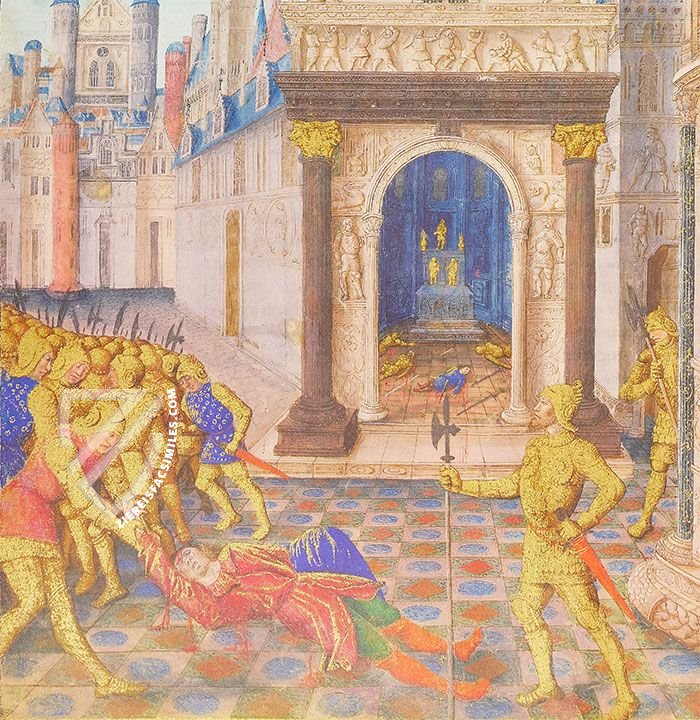
History of the Trojan War
The Abduction – or Seduction – of Helen
The mythology surrounding the Trojan War is complex, it was already hotly debated during antiquity and manifold versions of the story exist. Their differences hinge on questions regarding key aspects of the story, and one of the most important regards the nature of Helen’s departure from Sparta: was she taken by force or did she go of her own free will?
As soldiers carry off loot from the French Renaissance cityscape in the background, others brawl in the streets where the bodies pile up, one man has a dagger shoved into his throat as he falls to his knees. Jean Colombe puts an ambiguous look on Helen’s face and although two gauntleted hands hold her by the arm, it is unclear whether she and her handmaidens are being escorted or abducted.
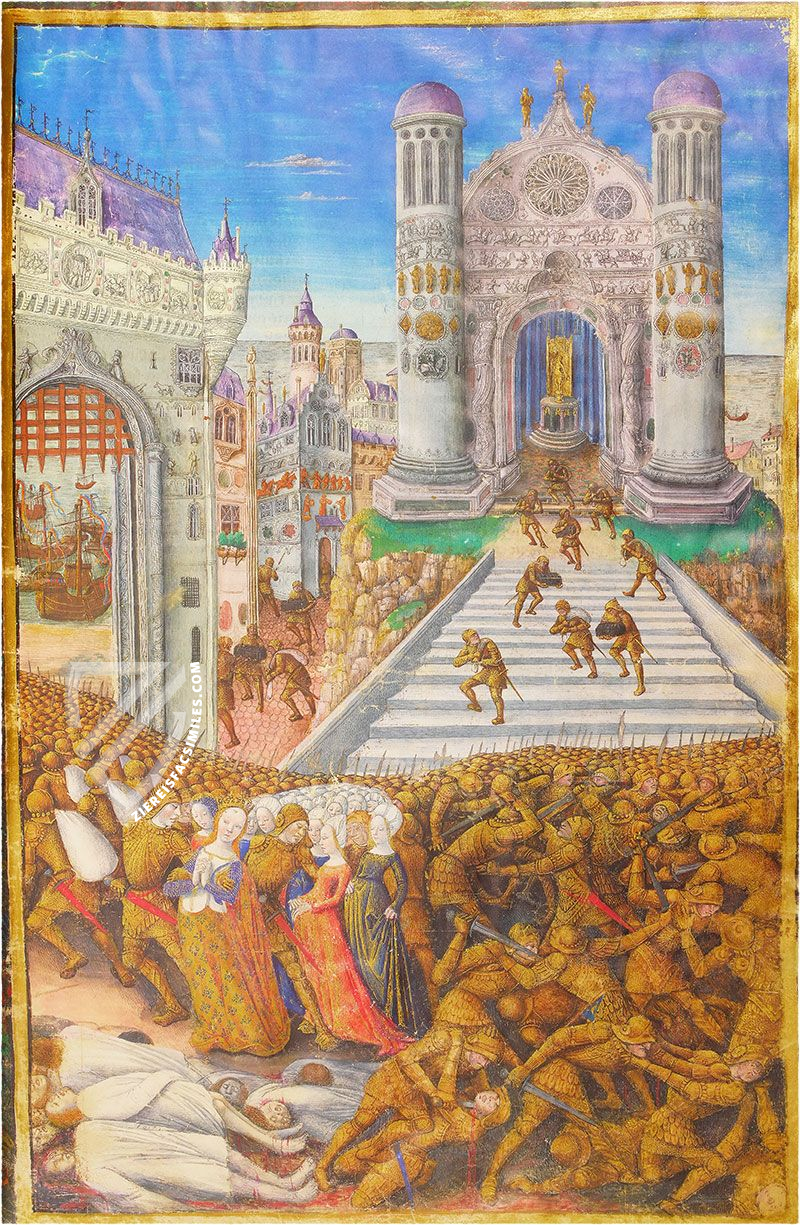
#1 Historia de la Guerra de Troya. Histoire de la Destruction de Troie la Grand
Language: Spanish
- Treatises / Secular Books
- Apocalypses / Beatus
- Astronomy / Astrology
- Bestiaries
- Bibles / Gospels
- Chronicles / History / Law
- Geography / Maps
- Saints' Lives
- Islam / Oriental
- Judaism / Hebrew
- Single Leaf Collections
- Leonardo da Vinci
- Literature / Poetry
- Liturgical Manuscripts
- Medicine / Botany / Alchemy
- Music
- Mythology / Prophecies
- Psalters
- Other Religious Books
- Games / Hunting
- Private Devotion Books
- Other Genres
- Afghanistan
- Armenia
- Austria
- Belgium
- Belize
- Bosnia and Herzegovina
- China
- Colombia
- Costa Rica
- Croatia
- Cyprus
- Czech Republic
- Denmark
- Egypt
- El Salvador
- Ethiopia
- France
- Germany
- Greece
- Guatemala
- Honduras
- Hungary
- India
- Iran
- Iraq
- Israel
- Italy
- Japan
- Jordan
- Kazakhstan
- Kyrgyzstan
- Lebanon
- Liechtenstein
- Luxembourg
- Mexico
- Morocco
- Netherlands
- Palestine
- Panama
- Peru
- Poland
- Portugal
- Romania
- Russia
- Serbia
- Spain
- Sri Lanka
- Sweden
- Switzerland
- Syria
- Tajikistan
- Turkey
- Turkmenistan
- Ukraine
- United Kingdom
- United States
- Uzbekistan
- Vatican City
- A. Oosthoek, van Holkema & Warendorf
- Aboca Museum
- Ajuntament de Valencia
- Akademie Verlag
- Akademische Druck- u. Verlagsanstalt (ADEVA)
- Aldo Ausilio Editore - Bottega d’Erasmo
- Alecto Historical Editions
- Alkuin Verlag
- Almqvist & Wiksell
- Amilcare Pizzi
- Andreas & Andreas Verlagsbuchhandlung
- Archa 90
- Archiv Verlag
- Archivi Edizioni
- Arnold Verlag
- ARS
- Ars Magna
- ArtCodex
- AyN Ediciones
- Azimuth Editions
- Badenia Verlag
- Bärenreiter-Verlag
- Belser Verlag
- Belser Verlag / WK Wertkontor
- Benziger Verlag
- Bernardinum Wydawnictwo
- BiblioGemma
- Biblioteca Apostolica Vaticana (Vaticanstadt, Vaticanstadt)
- Bibliotheca Palatina Faksimile Verlag
- Bibliotheca Rara
- Boydell & Brewer
- Bramante Edizioni
- Bredius Genootschap
- Brepols Publishers
- British Library
- C. Weckesser
- Caixa Catalunya
- Canesi
- CAPSA, Ars Scriptoria
- Caratzas Brothers, Publishers
- Carus Verlag
- Casamassima Libri
- Centrum Cartographie Verlag GmbH
- Chavane Verlag
- Christian Brandstätter Verlag
- Circulo Cientifico
- Club Bibliófilo Versol
- Club du Livre
- CM Editores
- Collegium Graphicum
- Collezione Apocrifa Da Vinci
- Comissão Nacional para as Comemorações dos Descobrimentos Portugueses
- Coron Verlag
- Corvina
- CTHS
- D. S. Brewer
- Damon
- De Agostini/UTET
- De Nederlandsche Boekhandel
- De Schutter
- Deuschle & Stemmle
- Deutscher Verlag für Kunstwissenschaft
- DIAMM
- Droz
- E. Schreiber Graphische Kunstanstalten
- Ediciones Boreal
- Ediciones Grial
- Ediclube
- Edições Inapa
- Edilan
- Editalia
- Edition Deuschle
- Edition Georg Popp
- Edition Leipzig
- Edition Libri Illustri
- Editiones Reales Sitios S. L.
- Éditions de l'Oiseau Lyre
- Editions Medicina Rara
- Editorial Casariego
- Editorial Mintzoa
- Editrice Antenore
- Editrice Velar
- Edizioni Edison
- Egeria, S.L.
- Eikon Editores
- Electa
- Emery Walker Limited
- Enciclopèdia Catalana
- Eos-Verlag
- Ephesus Publishing
- Ernst Battenberg
- Eugrammia Press
- Extraordinary Editions
- Fackelverlag
- Facsimila Art & Edition
- Facsimile Editions Ltd.
- Facsimilia Art & Edition Ebert KG
- Faksimile Verlag
- Feuermann Verlag
- Folger Shakespeare Library
- Franco Cosimo Panini Editore
- Friedrich Wittig Verlag
- Fundación Hullera Vasco-Leonesa
- G. Braziller
- Gabriele Mazzotta Editore
- Gebr. Mann Verlag
- Gesellschaft für graphische Industrie
- Getty Research Institute
- Giovanni Domenico de Rossi
- Giunti Editore
- Graffiti
- Grafica European Center of Fine Arts
- Guido Pressler
- Guillermo Blazquez
- Gustav Kiepenheuer
- H. N. Abrams
- Harrassowitz
- Harvard University Press
- Helikon
- Hendrickson Publishers
- Henning Oppermann
- Herder Verlag
- Hes & De Graaf Publishers
- Hoepli
- Holbein-Verlag
- Houghton Library
- Hugo Schmidt Verlag
- Idion Verlag
- Il Bulino, edizioni d'arte
- ILte
- Imago
- Insel Verlag
- Insel-Verlag Anton Kippenberger
- Instituto de Estudios Altoaragoneses
- Instituto Nacional de Antropología e Historia
- Istituto dell'Enciclopedia Italiana - Treccani
- Istituto Ellenico di Studi Bizantini e Postbizantini
- Istituto Geografico De Agostini
- Istituto Poligrafico e Zecca dello Stato
- Italarte Art Establishments
- Jan Thorbecke Verlag
- Johnson Reprint Corporation
- Josef Stocker
- Josef Stocker-Schmid
- Jugoslavija
- Karl W. Hiersemann
- Kasper Straube
- Kaydeda Ediciones
- Kindler Verlag / Coron Verlag
- Kodansha International Ltd.
- Konrad Kölbl Verlag
- Kurt Wolff Verlag
- La Liberia dello Stato
- La Linea Editrice
- La Meta Editore
- Lambert Schneider
- Landeskreditbank Baden-Württemberg
- Leo S. Olschki
- Les Incunables
- Liber Artis
- Library of Congress
- Libreria Musicale Italiana
- Lichtdruck
- Lito Immagine Editore
- Lumen Artis
- Lund Humphries
- M. Moleiro Editor
- Maison des Sciences de l'homme et de la société de Poitiers
- Manuscriptum
- Martinus Nijhoff
- Maruzen-Yushodo Co. Ltd.
- MASA
- Massada Publishers
- McGraw-Hill
- Metropolitan Museum of Art
- Militos
- Millennium Liber
- Müller & Schindler
- Nahar - Stavit
- Nahar and Steimatzky
- National Library of Wales
- Neri Pozza
- Nova Charta
- Oceanum Verlag
- Odeon
- Orbis Mediaevalis
- Orbis Pictus
- Österreichische Staatsdruckerei
- Oxford University Press
- Pageant Books
- Parzellers Buchverlag
- Patrimonio Ediciones
- Pattloch Verlag
- PIAF
- Pieper Verlag
- Plon-Nourrit et cie
- Poligrafiche Bolis
- Presses Universitaires de Strasbourg
- Prestel Verlag
- Princeton University Press
- Prisma Verlag
- Priuli & Verlucca, editori
- Pro Sport Verlag
- Propyläen Verlag
- Pytheas Books
- Quaternio Verlag Luzern
- Reales Sitios
- Recht-Verlag
- Reichert Verlag
- Reichsdruckerei
- Reprint Verlag
- Riehn & Reusch
- Roberto Vattori Editore
- Rosenkilde and Bagger
- Roxburghe Club
- Salerno Editrice
- Saltellus Press
- Sandoz
- Sarajevo Svjetlost
- Schöck ArtPrint Kft.
- Schulsinger Brothers
- Scolar Press
- Scrinium
- Scripta Maneant
- Scriptorium
- Shazar
- Siloé, arte y bibliofilia
- SISMEL - Edizioni del Galluzzo
- Sociedad Mexicana de Antropología
- Société des Bibliophiles & Iconophiles de Belgique
- Soncin Publishing
- Sorli Ediciones
- Stainer and Bell
- Studer
- Styria Verlag
- Sumptibus Pragopress
- Szegedi Tudomànyegyetem
- Taberna Libraria
- Tarshish Books
- Taschen
- Tempus Libri
- Testimonio Compañía Editorial
- Thames and Hudson
- The Clear Vue Publishing Partnership Limited
- The Facsimile Codex
- The Folio Society
- The Marquess of Normanby
- The Richard III and Yorkist History Trust
- Tip.Le.Co
- TouchArt
- TREC Publishing House
- TRI Publishing Co.
- Trident Editore
- Tuliba Collection
- Typis Regiae Officinae Polygraphicae
- Union Verlag Berlin
- Universidad de Granada
- University of California Press
- University of Chicago Press
- Urs Graf
- Vallecchi
- Van Wijnen
- VCH, Acta Humaniora
- VDI Verlag
- VEB Deutscher Verlag für Musik
- Verlag Anton Pustet / Andreas Verlag
- Verlag Bibliophile Drucke Josef Stocker
- Verlag der Münchner Drucke
- Verlag für Regionalgeschichte
- Verlag Styria
- Vicent Garcia Editores
- W. Turnowski Ltd.
- W. Turnowsky
- Waanders Printers
- Wiener Mechitharisten-Congregation (Wien, Österreich)
- Wissenschaftliche Buchgesellschaft
- Wissenschaftliche Verlagsgesellschaft
- Wydawnictwo Dolnoslaskie
- Xuntanza Editorial
- Zakład Narodowy
- Zollikofer AG






